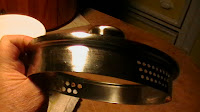 |
| Pan Lid - the true cover story |
At first glance, it doesn't seem like much. It's made to fit a certain pan, has a handle, yadda, yadda, yadda.
So? It's a lid. What else is there to say?
Plenty! Once you take the time to notice the subtle and not-so subtle differences between them.
 |
| One lid type has this profile |
Some have a flange-like rim. This keeps the heat in, and also keeps the lid on. I think a majority of lids have this flange thing in varying degrees of depth - probably for the same purpose.
 |
| Another metal lid with smaller flange |
What does a lid actually do?
Are there times when you don't want to cover your cooking?
These are important questions!
Knowing the right answer can literally make or break what you're trying to produce.
Everybody knows the heartache of broccoli that's been allowed to steam itself to death. There's nothing worse than discolored, mushy, overcooked broc!
So what's the secret? It seems to depend on what's cooking and how long its being cooked.
 |
| Specialty lid with vented edges |
Boiling water to cook pasta? A lid is good to use at first. This will help retain the heat and cause the water to boil quicker. Once the water has reached that rolling boil state, remove the lid and add the pasta. Cook it uncovered. That's very important. Otherwise the pasta will bubble over and you'll have quite a mess!
As a contrast, a lid is absolutely required when preparing things like rice, grits and other cereals. Covering and lowering the heat go hand in hand when it comes to these cereals. And as far as pressure cooking is concerned, it wouldn't be possible without a tight fitting lid and a gasket to keep steam from escaping.
As a contrast, a lid is absolutely required when preparing things like rice, grits and other cereals. Covering and lowering the heat go hand in hand when it comes to these cereals. And as far as pressure cooking is concerned, it wouldn't be possible without a tight fitting lid and a gasket to keep steam from escaping.
 |
| Enameled pan lid |
 |
| "Universal" lid |
 |
| My favorite glass lid w/ safety handle |
The most important thing to remember is these things get hot, so handle with care and a great deal of respect.
If you have any additional information on lids, or comments or recipes please feel free to submit them! In the meantime, Enjoy!



